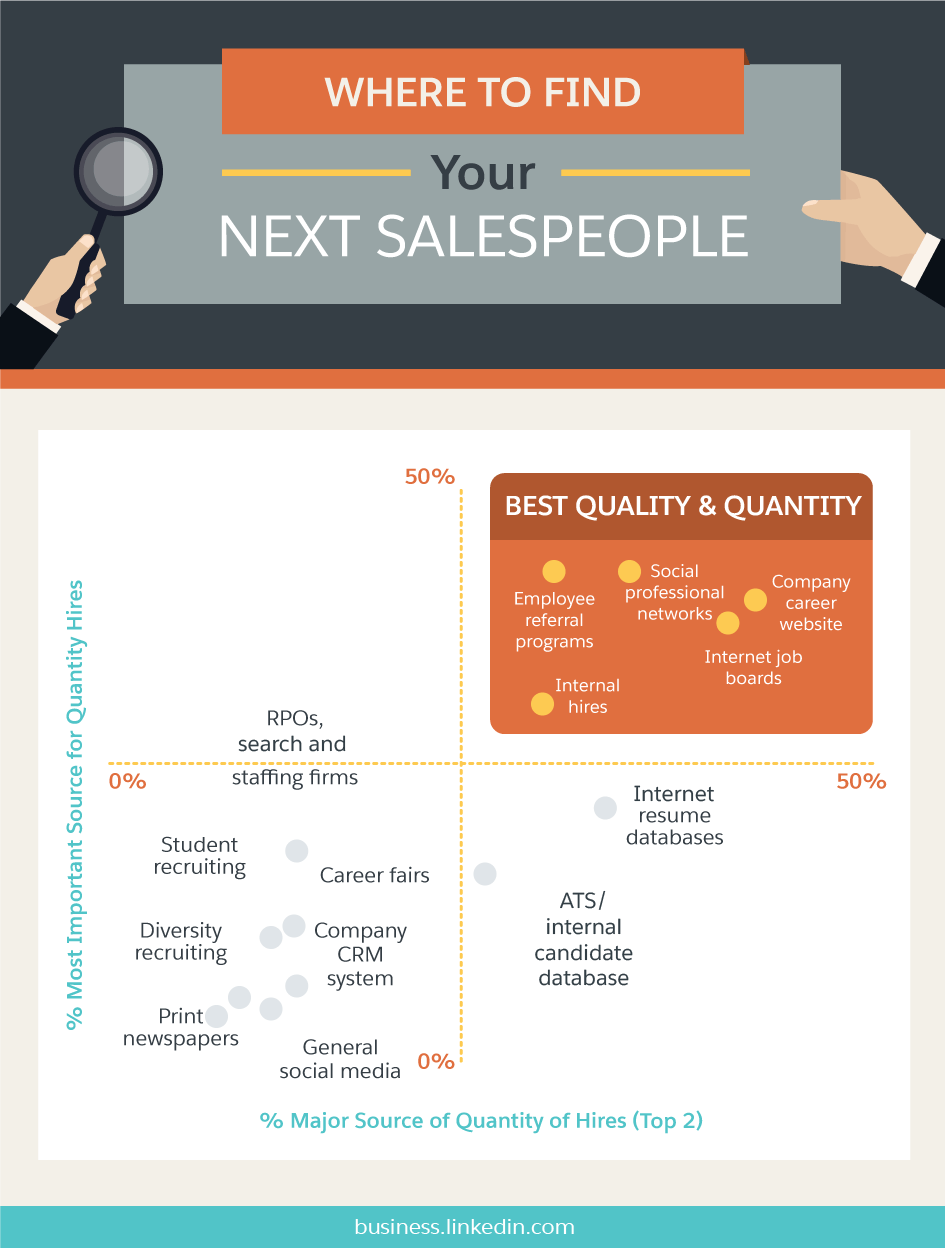For small- and medium-size businesses, hiring even a small team of talented and motivated salespeople can have a dramatic effect on the company’s revenue. The issue is that the very best performers are often already in positions where they are relatively content, and it’s up to the leadership team and hiring managers to find unique ways to engage with them in order to create a mutual interest. There’s so much that goes into the process, from culture fit to talent evaluation, that many managers are simply satisfied to have a working apparatus in place.
However, smaller organizations can excel in hiring sales talent and can position themselves as a brand that the best performers want to work for.
Sell your company to your sales candidates
The typical idea is that job interviews are a form of sales pitch, wherein the job seeker is selling their qualifications. But it’s less typical to talk about how the company is also pitching to the candidate. Both parties involved are analyzing information and trying to decide whether they are a good fit together—similar to when a salesperson pitches a prospect. When companies are going after high-quality talent, neither side holds a distinct advantage over the other. Each party has value to contribute to the arrangement, and they are pitching to each other.
Think briefly about the stereotypical and often unwanted qualities of “high-pressure” salespeople: They act as if you should be lucky to be offered their product. If you decide to walk away, they want you to know there are dozens of other people who would love to be in your shoes. If you make your candidates feel like they have nothing to contribute to the process, and that they should be honoured that your company would even consider them, then you’re going to end up with subpar candidates.
When you approach the situation by clearly communicating what value your organization will bring to the candidate’s life, you’ll attract potential employees who are in demand and have numerous choices about their next steps. You can also be confident that they’re approaching the transaction from the same perspective and with a desire to demonstrate what value they will contribute to your company. They’ll expect to discover why your organization is a beneficial choice for them, too.
Create a desirable talent brand
Many industry power players have established themselves as top-tier talent brands, thanks to their dedication to emphasizing attractive features of the company in order to recruit superior talent. You’ve probably heard of tech companies that entice creative engineers through unorthodox interviewing procedures, or financial services firms that offer incredibly comprehensive benefits packages in order to reduce employee turnover. These brands become famous for the defining characteristics of their hiring mechanisms, and great candidates know to look to them to fill their needs.
The Top Five Reasons for Investing in Talent Branding
- 49% - Increased belief in the impact of employer brand
- 41% - Planned increase in hiring
- 50% - Need to raise general awareness
- 42% - Increased competition
- 39% - Difficulty recruiting quality candidates

Large companies may consistently make headlines as well-known talent brands, but smaller organizations can create a definable brand around their hiring practices and reap the benefits of this strategy as well. It’s favorable for your company in terms of attracting talent, as companies with excellent talent brands see 2.5 times more applicants for open positions than other businesses. But it also makes sense financially: Talent brands that stand out generally spend 43 per cent less on hiring than average companies.
For SMBs, establishing a talent brand requires a combination of initiatives, including using content to enhance your messaging, streamlining and improving the customer experience, and emphasizing the attractive qualities of your organization.
Market a workplace culture that emphasizes the importance of sales
The best qualified and most talented salespeople won’t queue up to work at a company that is perceived to undervalue the sales team. If you want to attract the most in-demand sales reps and managers, the first step is to build a culture where the sales process is properly respected and understood.
The latter point is often overlooked as an aspect of the organizational culture as it relates to the sales team. One of the main reasons sales employees feel that their work isn’t valued is a belief that their colleagues in other functions simply don’t understand what they do. The sales reps may perceive that others reduce their actions and contributions to schmoozing or networking, neglecting to learn about the tiresome research, analysis, and work that goes into successfully selling.
Startup leaders who don’t come from a sales background may be inadvertently encouraging this kind of culture by elevating product development or engineering over the contributions of the sales department. It’s important to actively recognize and celebrate the role that sales professionals play in shaping the organization and contributing to the future success of everyone involved. Leaders can spotlight certain aspects of the sales process so that other employees who are unfamiliar with what it involves have an opportunity to learn more.
This doesn’t mean you should elevate the sales department over the other integral units of your organization. It’s about demonstrating to your team as a whole that everyone has important contributions to make to the company, and building an admiration for collaboration into the very essence of your company culture.
Your Next Sales Superstar is Likely a Passive Job Candidate
- 58% of Canadian companies recruit passive candidates
- Compared to a global average of 61%
- 75% of professionals consider themselves to be a passive candidate
- Active candidates:
- Actively looking for a new job
- Casually searching a few times a week
- Passive candidates:
- Reaching out to their personal network
- Open to talking to a recruiter
- Completely satisfied and don’t want to move

Learn how to create engaging job postings
Like any form of communication that is distributed by your company, a job posting reveals many things to its audience and often shapes their first impressions of your organization. Of course, it goes without saying that your posts need to be proofread, but there are ways in which you can go even further to engage your prospective candidates and provide them with reasons to click through to the application.
If you’re noticing a pattern, that’s because it’s fairly obvious. Once again, this sounds like the same language that is used when crafting a strategy to encourage customers to continue clicking on their way to a purchase. Remember, you’re not targeting your job posting to candidates who are desperate for an interview and will apply to any posting they see. You’re attempting to engage with a top performer at another firm who doesn’t have any immediate plans of leaving their position.
There are some simple guidelines that will help you achieve this. Address the job candidate directly, rather than referring to them in the third-person. Salespeople don’t say, “My ideal client is looking to increase productivity by 30 per cent.” They address their prospects as “you” or by their name. Be inclusive, rather than exclusive, in your job posting. Engaging with interested parties from diverse backgrounds can yield surprising results, and you never know where you might find a candidate who turns out to be a great fit with your organization.
Leverage relevant, value-added content to convey information
We live in a content-driven environment, and it’s paramount for companies to create helpful content for numerous situations. One of these situations is the hiring process, as content can convey a large amount of information to candidates about what it is like to work for your company. This is crucial, because the 2015 Report on Global Job Seeker Trends from LinkedIn reveals that uncertainty about what it’s like to work at a new company is the primary obstacle for changing jobs.
The most effective talent brands consistently use content across a variety of channels to their advantage. Using your owned media channels to promote engaging content aimed at job seekers is a necessary, but insufficient tactic. Younger candidates are increasingly turning to third-party websites in order to research companies. You also need to create content that is sales-specific and clearly communicates the value of joining the sales team of your company.
Where to Find Your Next Salespeople

Consistently evaluate your compensation packages
It is true that we are trending toward salary becoming a less important part of a candidate’s decision in favour of career growth opportunities and other benefits and perks, but the most talented performers are still looking for appropriate compensation. If you expect to pique the interest of excellent sales professionals, you have to be prepared to pay them as if they are among the best.
Your entire compensation structure should be reviewed at least every six months in order to ensure that it remains competitive with other companies that your desired candidates are employed by. This includes base salaries, commissions, bonuses, benefits, professional development opportunities, and company perks.
Provide the candidates with a top-notch experience
A key factor in sales is getting the details right, and it’s just as important when attempting to hire your salespeople as well. The candidate is your customer in this endeavour, and you must take care to provide them with an exceptional customer experience throughout the process. Your ideal candidates will likely have other options they can pursue if any aspect of their experience with your company is lacking, meaning even elements that seem trivial must be handled properly.
Some ways you can enhance the experience for your candidates include:
- Making the online application process simple and efficient (especially on mobile devices)
- Responding promptly to questions and other communications
- Keeping appointments
- Ensuring travel arrangements are arranged in advance
With excellent branding, content, compensation, and an easy application process, your company can attract the most successful salespeople in the industry. Add in a solid company culture, and your sales team will stay long term and keep your company profitable.
Share "Here’s How to Attract Stellar Salespeople—and Keep Them" On Your Site



